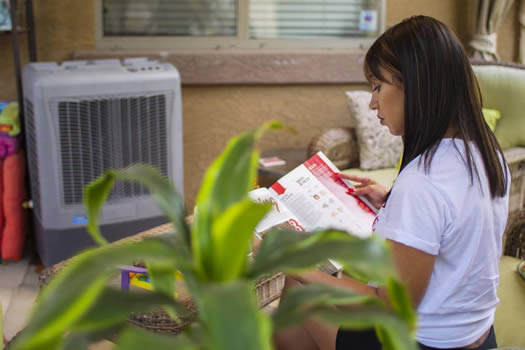Evaporative Cooler Maintenance
If you own or are considering buying a swamp cooler, you will need to perform some evaporative cooler maintenance on the unit periodically to keep it running efficiently.
Let's look at what is involved in this.
 Evaporative coolers, also referred to as swamp coolers and ventless portable air conditioners, use less than quarter of the electricity that an air conditioner would generally use to cool a space roughly the same size.
Evaporative coolers, also referred to as swamp coolers and ventless portable air conditioners, use less than quarter of the electricity that an air conditioner would generally use to cool a space roughly the same size.
Where Evaporative Coolers Are Used
These units are used in warm climates that have fairly low humidity for best results. They draw warm air from the room into the unit and utilize soaked absorbent pads to cool the air passing through them by evaporation by as much as 20 degrees.
This chilled air is blown out the front of the unit into the room to cool it down. Swamp coolers also clean and filter the air, absorbing odors, smoke, dust and other pollutants.
However, if a cooler is not regularly maintained properly, it is possible that harmful bacteria, fungus and mold can accumulate. Spores can spread throughout the house unseen.
Here's what needs to be done to keep your cooler doing its job effectively:
- Clean the unit and have it serviced annually
- At the start of each cooling season, replace water pads. Check them over each month while the unit is in operation. If the pads have gotten dirty, simply replace them. Clean pads will ensure the environment is safer and the unit is more energy-efficient
- Empty the water reservoir when the cooler is not being used. Bacteria can breed in stagnant water
- When in use, ensure a window is open a crack to allow air circulation and reduce indoor humidity
Here is some more information on humidity indoors.
Humidity
Every time the occupants of a home bathes, showers, cooks or just breathe s and perspires, the amount of moisture in the air increases.
That means when these activities happen indoors, the humidity level inside the home is raised. Humidity is another way of saying the level of water vapor present in the air.
Humidity makes the air (and us) feel wet and clammy and it can start to smell musty. Humidity makes the indoor air feel even warmer during a hot summer day. This is because it prevents perspiration from evaporating from the skin, which undermines the body's natural way of remaining cool.
Evaporative coolers also raise the humidity inside a home as they cool the air. For this reason it is important to maintain airflow circulation throughout the house by opening a window at each end of the house to provide a cross draft.
Indoor Relative Humidity
Out of interest, relative humidity is the amount of water contained in the air compared to the amount it could potentially contain at a specific temperature.
At 100% relative humidity, the air has reached a point where it retains the maximum amount of moisture possible without precipitation at that temperature.
Most people feel comfortable indoors when the relative humidity stays at 30% to 60%. Below 30% humidity level, the air feels very dry and can actually cause harm to a home's structural integrity as well as to the occupants' health.
On the flip side, above 60% humidity the air feels too wet. This can also be harmful to both the home and its occupants.
High humidity can provide a breeding ground for mold and other fungal growths, certain pests and even wood rot in homes. It is also more likely to cause people to experience heatstroke, heat exhaustion, dehydration and headaches than would occur in a less humid atmosphere.
Dehumidification
In an attempt to reduce humidity levels inside the home, it is common to run the air conditioning unit or even use a dehumidifier. Air conditioning can improve air quality and it also reduces the humidity level as it cools, but this can also result in higher energy bills.
As an alternative to air conditioning, homeowners can install a whole-house dedicated dehumidification system to battle humidity. This type of system can be programmed to maintain pre-determined specific humidity levels. This allows homeowners to customize their home's comfort level which improving the effectiveness of evaporative coolers if this type of cooling is being used.
Posted: June 17, 2021
[Back to Top]